Studiolo of Francesco I
The Studiolo is a small painting-encrusted barrel-vaulted room in the Palazzo Vecchio, Florence. It was commissioned by Francesco I de' Medici, Grand Duke of Tuscany. It was completed for the duke from 1570-1572, by teams of artists under the supervision of Giorgio Vasari and the scholars Giovanni Batista Adriani and Vincenzo Borghini.
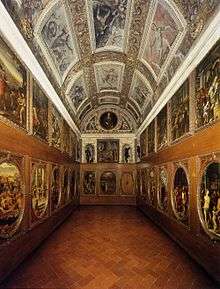
This small room was part-office, part-laboratory, part-hiding place, and part-cabinet of curiosities. Here the prince tinkered with alchemy and kept his collection of small, precious, unusual or rare objects. The walls and ceiling were decorated with paintings showing a similar variety of subjects, some showing exotic forms of industry and others mythology. The inset paintings are now all that remains in the room of the original contents. They are rather larger than what is normally meant by the term cabinet painting.
The late-Mannerist decorative program of paintings and sculpture was based on items encompassed by the collection. The object collection itself was stored in ~ 20 cabinets. In the center is a fresco of Prometheus receiving jewels from nature, commenting on the interplay of divine, nature, and humanity, that is the goal of both artistic and scientific interests.
Paintings

The walls were also covered with 34 paintings representing mythologic or religious subjects, or representing trades. The arrangement was such that paintings were somehow related to their neighbors, and emblematic of the objects in the cabinets below. The arrangement we see today is somewhat speculative; and the relationships are not always clear. For example, Tommaso d'Antonio Manzuoli's Diamond Mines hangs above the Maso de Sanfriano's Fall of Icarus. The painting by Giovanni Battista Naldini of the House of the Dreams emphasized the relationship with the adjacent bedroom of the Prince. The Studiolo is arrayed and visible through an arched opening and lacks cabinets, which fails to accurately recreate the claustrophobic feel of the original. In addition, originally a portrait of Francesco's mother, Eleonora of Toledo by Bronzino, kept vigil.[1]
While the Studiolo employed many of the best of contemporary Florentine painters, their work in this room, for most, does not represent their best efforts. The room itself is now more interesting as an example of an introverted and eccentric monarch; from an artistic viewpoint, the style of these paintings is the high point of Florentine Mannerism, as reflected in the affected and contorted crowds in the canvases. The pseudo-allegiance to the sciences couple with the sense that they illuminated the educated monarch, suggest a prescient hint of the encyclopedic philosophy of Enlightenment. However, Francesco ultimately was a poor representative of the inquisitive mind; at best this room served as a tinkerer's closet, a place for this personally awkward monarch to find seclusion from his wife, family, and court. Not long after the death of the Grand Duke, it was neglected and dismantled by 1590, only to be partially reconstructed in the twentieth century as a Renaissance oddity within the medieval palace.
Contributing artists to the Studiolo
- Alessandro Allori(Pearl Fisherman).
- Bartolomeo Ammannati Ops[2]
- Niccolò Betti
- Ludovico Buti The armory
- Giovanni Maria Butteri [3] (Francesco visiting glassworks)].[4]
- Elia Candido Aeolus[2]
- Vittore Casini (The Forge of Vulcan
- Mirabello Cavalori (Lavinia at the altar).
- Jacopo Coppi called "il Meglio" ("the Best") (The invention of gunpowder)[5]
- Francesco del Coscia
- Giovanni Fedini
- Alessandro Fei called il Barbiere (the Barber)
- Stoldo Lorenzi Galatea[2]
- Sebastiano Marsili
- Girolamo Macchietti (Medea and Jason)
- Andrea del Minga
- Lorenzo dello Sciorino (Hercules and Ladon
- Francesco Morandini (called il "Poppi") and Jacopo Zucchi for the ceiling
- Giovanni Battista Naldini Allegory of Dreams and the Gathering of Ambergris.
- Carlo Portelli
- Maso da Sanfriano (Flight of Icarus).
- Stradanus (Francesco in his laboratory).(Alchemy laboratory)
- Santi di Tito with (The Sisters of Fetonte) (Phaeton; Hercules and Iole)
- Bartolomeo Traballesi (Danae)
- Lorenzo Vaiani "dello Sciorina"
- Giorgio Vasari himself
- Jacopo Zucchi
Gallery
| Statuary Niches and Portraits of Francesco's Parents | ||||||
|---|---|---|---|---|---|---|
| Ovals of Studiolo | |||||||
|---|---|---|---|---|---|---|---|
 |
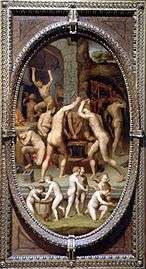 |
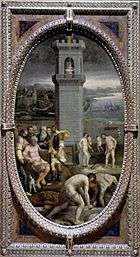 |
 |
 |
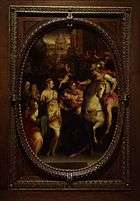 |
 |
 |
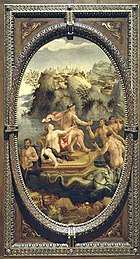 |
 |
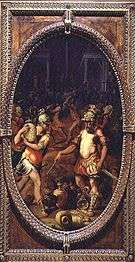 |
 |
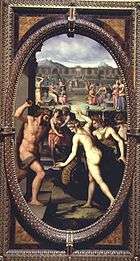 |
 |
 |
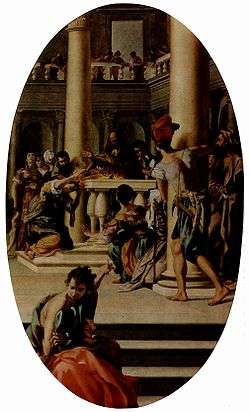 |
| Upper Rectangular Canvases of Studiolo | |||||
|---|---|---|---|---|---|
 |
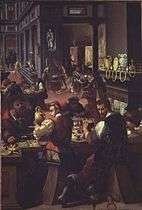 |
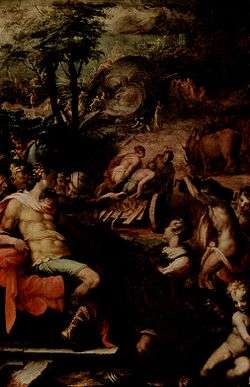 |
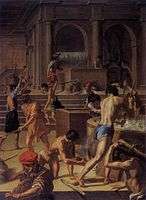 |
 |
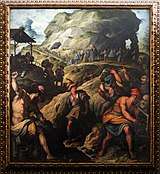 |
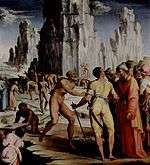 |
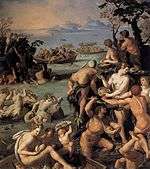 |
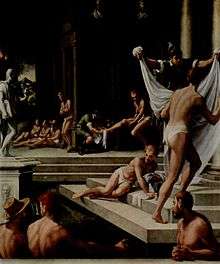 |
 |
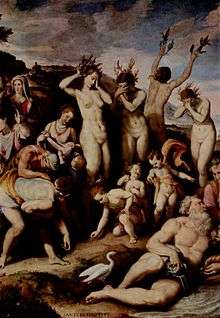 |
 |
References
- Christopher Hibbert, The Rise and Fall of the House of Medici (1979), Penguin Books
- Cole, Michael W. (2011). Ambitious Form: Giambologna, Ammanati, and Danti in Florence. YPrinceton University Press. p. 64. ISBN 978-0-691-14744-4.CS1 maint: ref=harv (link)
- Biography.
- .
- Schaefer S. The Invention of Gunpowder Journal of the Warburg and Courtald Institutes. (1981) p209-211.
- http://www.artic.edu/aic/exhibitions/medici/themes.html
- https://web.archive.org/web/20060305135411/http://www.italica.rai.it/rinascimento/parole_chiave/schede/studiolo.htm
- https://web.archive.org/web/20040829205611/http://www.museoragazzi.it/MuseoRagazzi/db36cedt.nsf/pages/fr_studiolo
- https://web.archive.org/web/20051113175416/http://mypage.bluewin.ch/schupposc/studio.htm
External links
- For excellent photos see http://www.abaxjp.com/gw04-studiolo/gw04-studiolo.html
![]()
